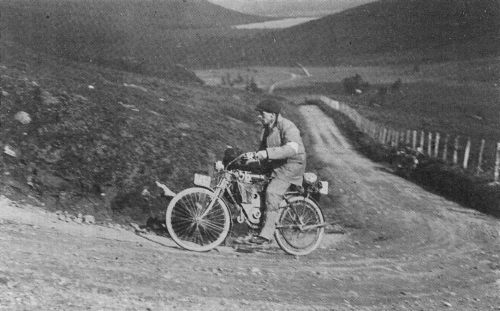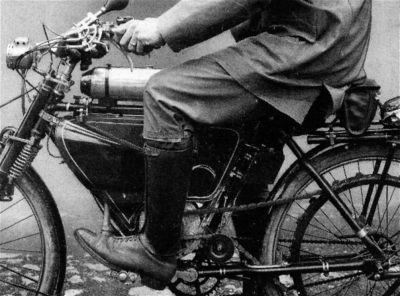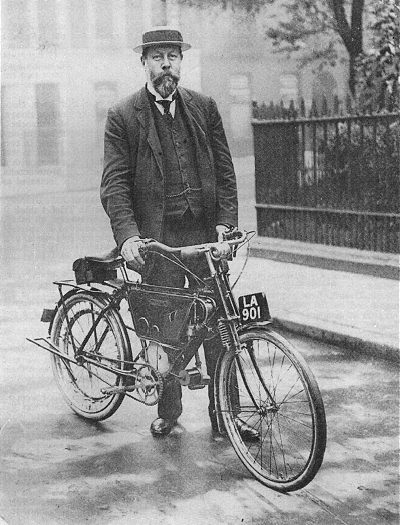 Go
to the Archive index
Go
to the Archive indexI went to the company H & A Dufaux England Ltd approximately in 1908 from Rover Co as a traveller. I had never done any selling previously, but I found I was able to interest the agents. When I went to the company at 65 Holborn Viaduct all the capital had been used up. Though the machine, the Motosacoche 1¼hp, was creating much interest only a few were being sold. I started off from no.65 with a long leather lined overcoat and a case on a carrier. I felt like a round of beef on a tom tit! (I couldn't understand why I was tugged downwards on left side frequently - it was the corner of my long motor coat being caught by the pulley.)
My first stop was Colchester. I would stop at a hotel on edge of town, clean my machine, take off overalls and ride up to the most important looking shop or garage, ask for the manager and when my name was requested I replied "Mr Motosacoche". It went OK and in three months riding around the coast and barging inland to any town of 10,000 or over, I had sold more than the company had in three years. In two years, to the best of my recollection, I had all the capital back and worked sales to 900 per annum. At the Olympia shows I had a "Sachoche" on top of our sign hung with a wire from the roof with the sign "Still on Top". (I altered the name to Motosacoche Limited and was made Managing Director.) The first machine was l¼hp, increased to 1½hp then to 2½hp.
With the trials we always got away with a gold medal, thanks to J S Holroyd, who was a tip-top pedaller. He put up a wonderful show in a Scottish Trial, I think it was in 1910, the only man and machine to go from Braemar and Grantown, all others failed and were sent another route, and for which we were also awarded a "special" gold medal. The Douglas family, who were rivals, got away with the gold medal and advertised that winning medals was a habit the Douglas had acquired - Ha! Ha! thought I, this is where I come in, and I advertised "Winning Gold Medals is a habit the Motosacoche has always had".

J S Holroyd rides a Motosacoche up Armurlree Hill
in the 1910 Scottish Six-Days Trial.
We were worried over the belt hook - belt ends would pull through. Every year I would ride all over England, Scotland and Wales looking up agents and fixing others. Once in Devon where one wants a ladder to climb some of the hills, my belt gave me trouble and on the journey I thought out a way to overcome it. I reached Tiverton and after all had gone "bysey" I asked Boots to make up the fire and bring me a jug of coffee. I had bought a piece of steel wire before arriving at the pub and I fashioned out another hook with the aid of the fire, pliers and hammer. This hook I hooked in the belt folds (it was a round, twisted, chrome leather folded belt) with my new hook which at one end was a loop or ring into which the joining link was hooked-so it gave a double purchase - I patented it. Terrys of Redditch made them and we sold thousands. The machine shops in Belgium and other continental towns had seen them on Motosacoche machines in their towns and as many shops used these round twisted belts, my system was a godsend to them - the Specification 8109 of 1909.
Then the motor cycle papers urged two speed gears - another trouble. I went to the works in Geneva and urged them to make such. They said the rider was the second speed and the machine was so small and gear box too heavy, so I set to work and made an expanding pulley with ball race at inner diameter for "free engine". A pedal opened and shut the flanges and at the same time pulled up and put down the jockey pulley - it gave from 5:1 to 9:1 and worked well. Then I became anxious as to exhaust valves when we made more powerful engines, for it will be remembered by old timers how the 3½hp thumpers broke them. It was then thought that the spring was responsible so I devised a scheme with the spring on top and the valve air-cooled. It worked OK as will be seen in the reprint from "Motor Cvcling" (somewhat 'worn'). I had to satisfy the Geneva works it was OK. I was the first motorist to reach the top of the glacier De Rhone. (The machine with mushroom or standard valves which I stipulated must be used, a competitor failed early through overheat. Specification No 17201, 1911.)
I was being worried about 1911 with competition - Humber, Douglas and many others getting interested with lightweights and I felt our light would be blown out. They made everything, we, only the engine, so I started the works thinking. I assured them that if they could make me a 1,000cc twin and as good as they made the little 1¼ I would sell them in thousands. After a year's thought and taking my advice, they got to work. I gave the first to Harry and Charlie Collier2 and assured them that if they built a bicycle around it, they could be charmed. They bought many thousands. I started the Enfield Company in the motor cycle world3, they bought 3,000 small 2½hp twins. I had formed another company, the MAG Engine Co Ltd, to deal with these engines and sold approximately 20,000, if my memory serves me right.
I once received a letter from Oxford, reading somewhat as follows: "When next you are in Oxford I'd like you to call as I'm interested in your Motosacoche - W Morris, Long Wall, Oxford (I think that was the address). I called and saw him and he took the agency. He had a small shop and a boy to help. He is now Lord Nuffield and has given away approximately £23.000,000. A truly wonderful and good man. I feel I was the first to introduce him to petrol engines.
A copy of testimonials will show one from T S V Phillips, Lieut. He was to become an admiral, and went down with the Prince of Wales in the war with Japan. Also one from his pal, whom he brought to introduce to me, George Battenberg. He said he had no money so I told him to take any machine he fancied! His sister later on came and paid for it - Ena, who became Queen of Spain. I didn't get much money but I did see life!
The old timers will well remember LPA, which indicated light pedal assistance. One spat blood at the top of a corker of a hill.

This 1908 picture of a Motosacoche shows the
belt jockey pulley referred to in the text.
The rider is J Stuart White.
At one quarterly trial, from Chequers at Uxbridge to Banbury and back, when we left Banbury my front tyre punctured on the rise out of the town. I had to think quickly. if I repaired it I would lose marks, so I decided to ride on the rim and what anxious moments I had when a bend in the road was coming towards me. I bad to coax the cover on the side of the rim to keep it off the road. It shook my sock suspenders down and stopping in some teeth loosened. All riders avoided me as if I had some contagious disease. At Rectory Hill, Amersham, we had to be timed up the precipice. Here was trouble for me. Ebby told me to get ready. I lifted the back wheel off the road, kicked the pedal and started the engine. When she was turning fast, I let down the jockey pulley4 and put down the wheel; when I got the order to go I pedalled hard, the bike was all over the road and when I got it about 5mph I pulled up the jockey. Well I pedalled all I knew, got over the brow of the hill and saw an observer along the road. It was the one and only Muriel Hind. I hadn't a kick left and I fell up against her but I kept moving slowly. "Poor old boy" she said and off I went. About a mile on Billy Cooper came up alongside and we had a ding dong go, he on his Bradhury 99 (remember?) and I left him, I think he was scared of the clatter I kicked up and the wobbles. At Uxbridge as I passed the Chequers I got a cheer but didn't stop - discretion better. Rushed home to Turnham Green, done, whacked, all my hones rattled for 50 miles or so. Next morning I took off the cover, only valve was left, but cover (beaded edge) unhurt. I sent old Drew-Conybeare St B'ham a testimonial, maker of Druid forks, and he used it in his advertisements for many months.
I won a petrol consumption trial in the Tring district - 242 to the gallon. Dr A M Low measured in the petrol if my memory serves me correctly. Well, I had passed many who had come to rest and was still safe and wondered if any more were in the running when I began to notice drops of oil on the road. I then saw round a bend a competitor who was in trouble. At that time I heard ominous sounds coming from my carburettor so I leaned machine so petrol outlet was at lowest position and trusted to providence! Suddenly the rider in front conked and stopped. I was soon up to him - H K Oily5 and his wonderful Dreadnought. My pup engine ran on its reputation for about 50 yards and threw in the sponge.
Holroyd, Le Vack and I entered a race at Brooklands. To our astonishment we were on the mark with Stanley on Singer, Pullin on Rudge, Horsman on Triumph and some others. I tackled Ebby on the matter before the word "Go" and he replied "Well you are In the trade, and you ought to have something good and fast". We did - we only saw our competitors at the start and when we came in they were having tea.
We were known as makers of the Motosacoche Motosasquash Motosausage - the name means motor in a case, ie: French translation. The case in mind is the one which was fitted in the frame in early cycles. The later riders will not have seen them.
When I was trvelling at night on business and went to the reception office, the lady, if it was a first class hotel, would look at me and regret there were no vacant rooms that night and I'd finish at a second or third rate puh. I found the reason - I bad a Captain Kettle beard and insects attracted by the acetylene lamp missed it and got in my moustache and beard and when I went in a warmed hotel they walked out, so the lady must have thought "Gracious, the man's alive!" We had an agent in Cambridge who also had a hairdressing shop in another part of town. I got into his chair and had the lot cleaned off and, when I reached London and home, my wife didn't know me.

1909 1¼hp Motosacoche
When England left the gold standard it made it impossible to trade with Switzerland. The business was wound up, all creditors paid in full and directors received a financial gift. I had a very happy 20 or so years with the concern and with my admirable friends in Geneva, their productions were par excellence as is all Swiss work.
The "anonymous author"1 is surely Osborne Louis de Lissa? I say this because there are two unambiguous references to patents applied for in the author's name: 8109 of 1909 and 17201 of 1911.
Inputting these to the search facility on the Patent Office's on-line database gives results for both. The joint applicants for the first one being Dufaux Ltd and Osborne Louis de Lissa, and the second Motosacoche Ltd and Osborne Louis de Lissa. The company names tie in well with the above article.
There is also reference in the article to racing at Brooklands and Peter Hartley's "Bikes at Brooklands in the Pioneer Years" confirms there was an Oliver (not Osborne) de Lissa on Motosacoches racing contemporaneously with the names mentioned. The book mentions a special valve arrangement devised by de Lissa and the patents database confirms that this too was patented by Osborne Louis de Lissa.
So I think we can conclude that Oliver de Lissa and Osborne Louis de Lissa were one and the same and author of the article.